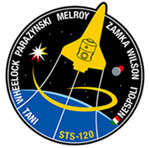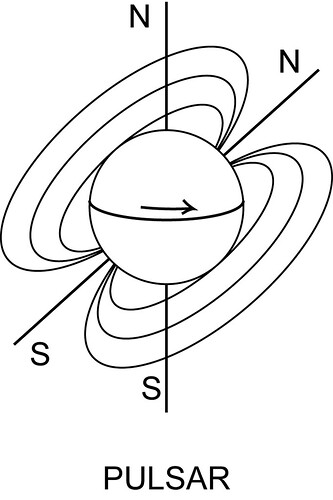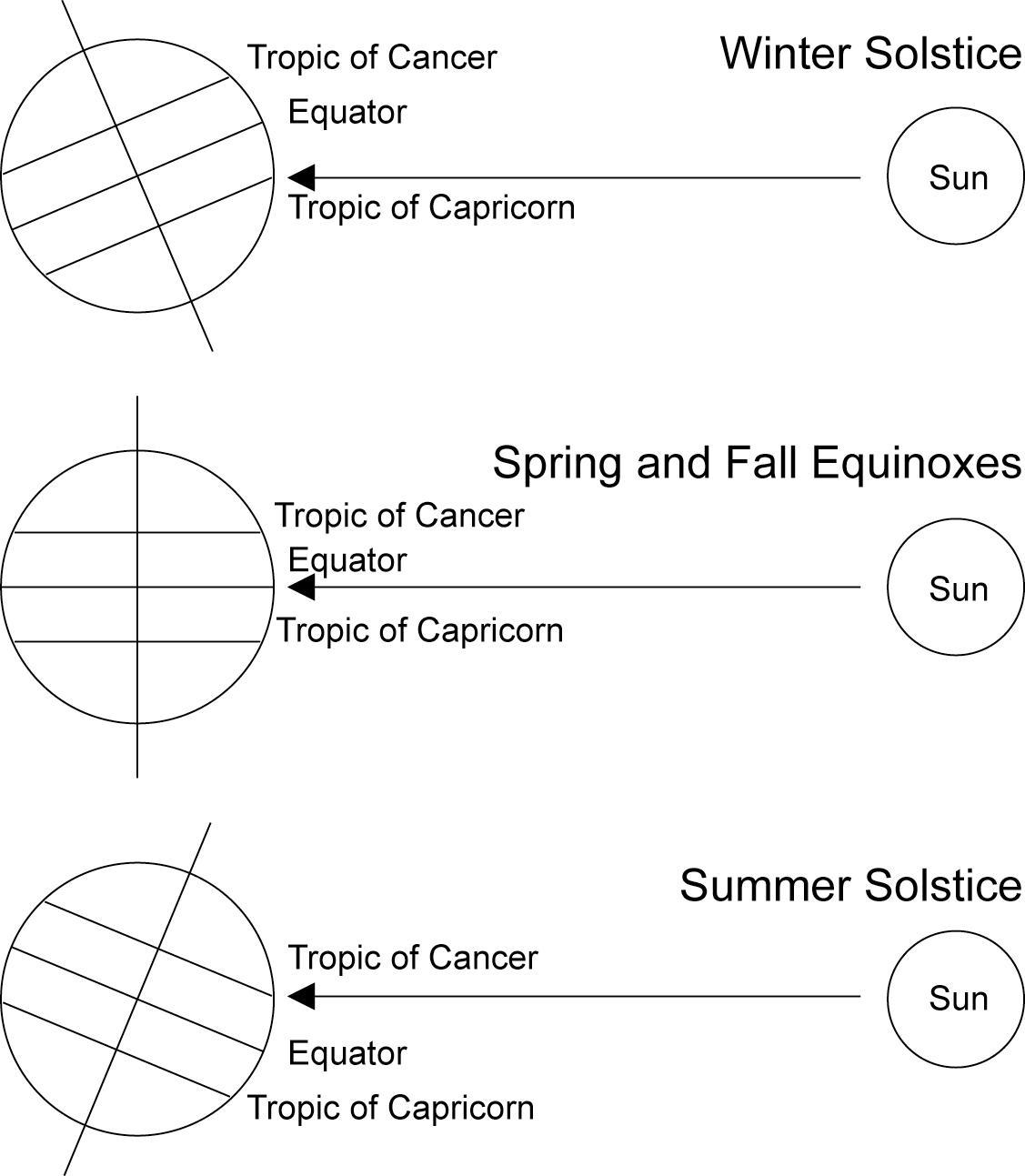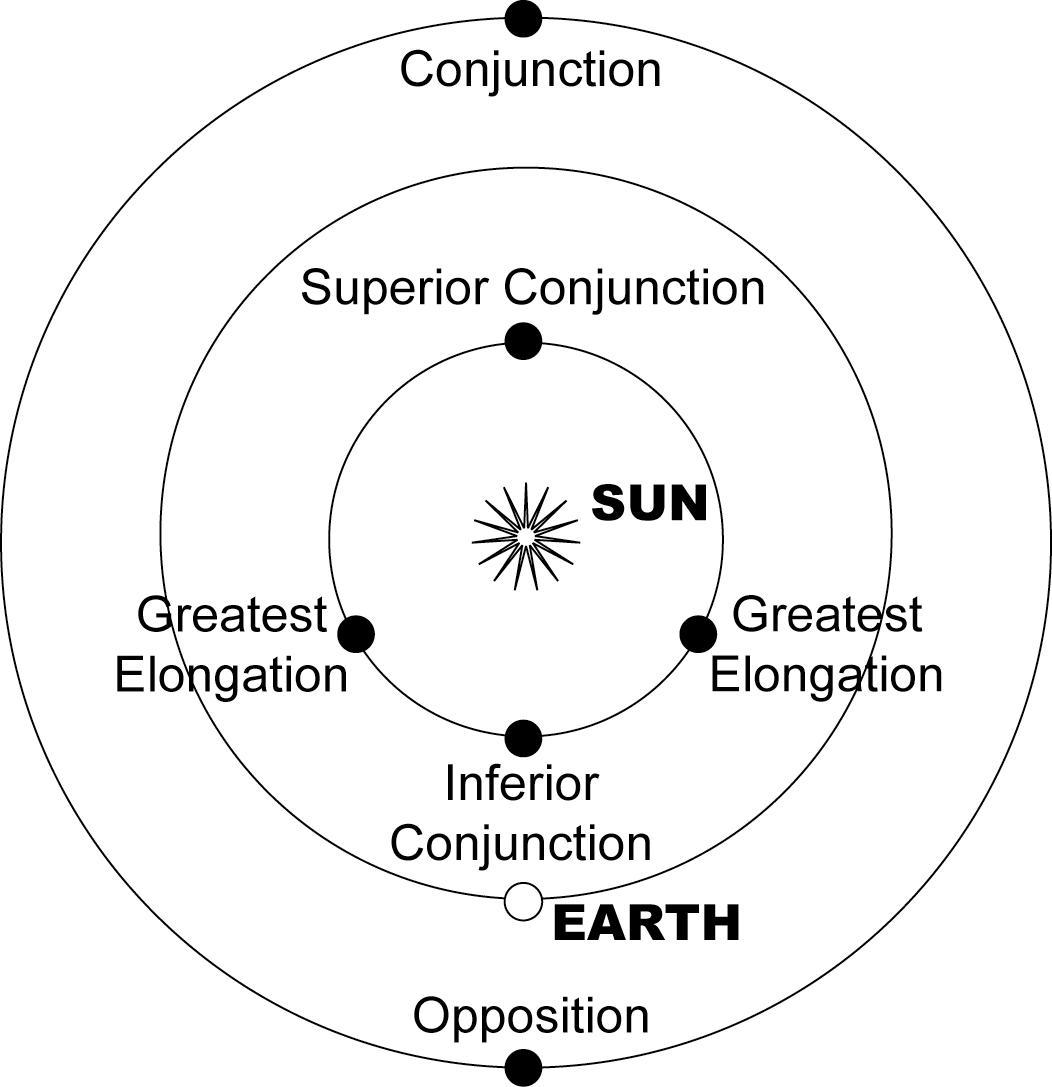 What’s Up with the Shuttle?
What’s Up with the Shuttle?
The space shuttle has become such a normal part of space life that now we only hear about it on the network news when something terrible, like the Columbia disaster, happens or when some new “first” takes place on board. So, let’s take a look at what’s … up … with the STS (Space Transportation System) missions.
Most Recent Mission: STS-118
STS-118 was the most recent mission, which returned on August 21, 2007 – and on board was Educator Astronaut Barbara Morgan (the successor to Christa McAuliffe). They also worked on construction of the right truss of ISS. This was also the first mission where the ground crew inspected the tiles using super-spiffy hand-held electronic scanners. In all previous missions they would just look at the tiles, and physically measure the size of visible cracks.
STS-118 was on the shuttle Endeavor, one of the 3 shuttles still flying.
Credit: NASA
Caption: STS-118 Patch
(I can’t find out what happened to STS-119, there is no current mission with that number. I suspect they changed the numbering to match up with the shuttle flight number. STS-118 was the 119th shuttle mission. STS-120 will be the 120th shuttle mission.)
Next Mission: STS-120
STS 120 will likely be on the shuttle Discovery and be commanded by Pamela Melroy. Though all but one crewmember are American, this group shows a great mix of cultures, races, and genders, which speaks to how far we’ve come since the beginning of spaceflight. The launch is scheduled for October 23, 2007.
They’re installing a multi-port module to ISS – one of the most important parts. This multi-port, named Harmony, will connect several different sections of the station together, and allow people to move between “rooms” on board. This will afford you and the media are plenty of opportunities to make puns about international cooperation, connections, gateways, and united, multi-country effort. There’s already a similar one on board – it’s called “Unity” and connects the US and Russian laboratory modules.
Credit: NASA
Caption: STS-120 Patch
Shuttle Orbiters in Review:
Enterprise – test flight only, not outfitted for space travel
Columbia – deceased
Challenger – deceased
Atlantis – Just flew STS-117 in June, 2007
Endeavor – Just flew STS-118 in August, 2007
Discovery – Scheduled to fly STS-120 in October, 2007
Want More?
 Mars Hoax Again
Mars Hoax Again
For those of you who are connected to the astronomy education world, it’s that time of year: the “Mars will be as big as the Moon” e-mail is going around again. The short answer is “Nope.”
The Beginning:
Mars and Earth regularly pass “close” to each other, but not that close. Astronomers get excited because we’re at “closest approach” or “opposition,” so our ground-based telescopes have a better view of Mars. Will you see a difference without a telescope? Not really, Mars may be a little brighter or a little redder, but it will still look, to your eyes, just like a star.
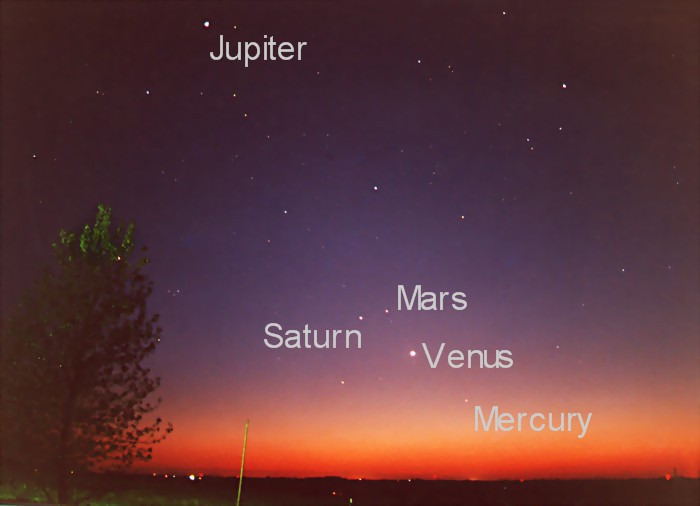
Credit: Dan Bush
Caption: This is what planets look like to the naked eye.
This e-mail hoax started in August 2003, when Mars was actually very close, astronomically speaking. It was a mere 35 MILLION MILES AWAY. Since then, the e-mail has been going around every August, with the date slightly changed.
The Truth:
In 2007 Mars will be at opposition in December, not August, and it will still be 55 million miles away.
Here is what some scientists are saying:
Dec 18, 2007- Closest approach of Mars and Earth (0.589 AU = 88.42 million km). Apparent diameter of Mars is 15.88″ (seconds of arc). The apparent diameter of the Moon is about 1/2 degree which is 1,800″ (seconds of arc). So, will Mars look as big as the Moon? Not even close. [1 degree = 60 arcminutes – 3,600 arcsec]
-Alan Gould, UC Berkeley
The Moon and Mars could not look alike in the sky, BUT an astronomer might say that that through a telescope at 100X, Mars _through a telescope_ might look almost as big (1,588″) as the Moon to the unaided eye (1,800″). Perhaps the part of the comparison about looking through a telescope was lost, and media types looking for a hype to hang a story on ran with it. That’s the only explanation I can give about the recurring story about Mars being as big in the sky as the Moon. This story reappears at almost every opposition of Mars, especially the really close ones.
– Steve Berr
Let Them Down Easy:
So what do you say to someone who is excited? Cover each of these topics:
- Validate the excitement
- Point out something related that will be cool
- Correct the misconception
- Invite them to view/look up something real
For example:
“So did you hear about Mars being as big as the Moon?”
“Yes! I agree, that would be awesome. You know, December is really going to be the best month to view Mars though, maybe we could take out a telescope together? Unfortunately, it’s still really far away, so it won’t ever look as big as the Moon. Also, if you want to see something cool sooner, on August 27 there will be a lunar eclipse, and the Moon itself will look red!”
Want More?
http://www.badastronomy.com/bad/news/marsattacks2005.html
http://en.wikipedia.org/wiki/Apollo_moon_landing_hoax_accusations
http://www.snopes.com/science/mars.asp
 Quasars vs Pulsars
Quasars vs Pulsars
Ever get pulsars and quasars confused? I do – they both sound to me like something from Star Trek that you use to stun the Romulans. The words may sound alike, but the objects aren’t even similar. Here’s the short answer: a pulsar is a star, and a quasar is a galaxy.
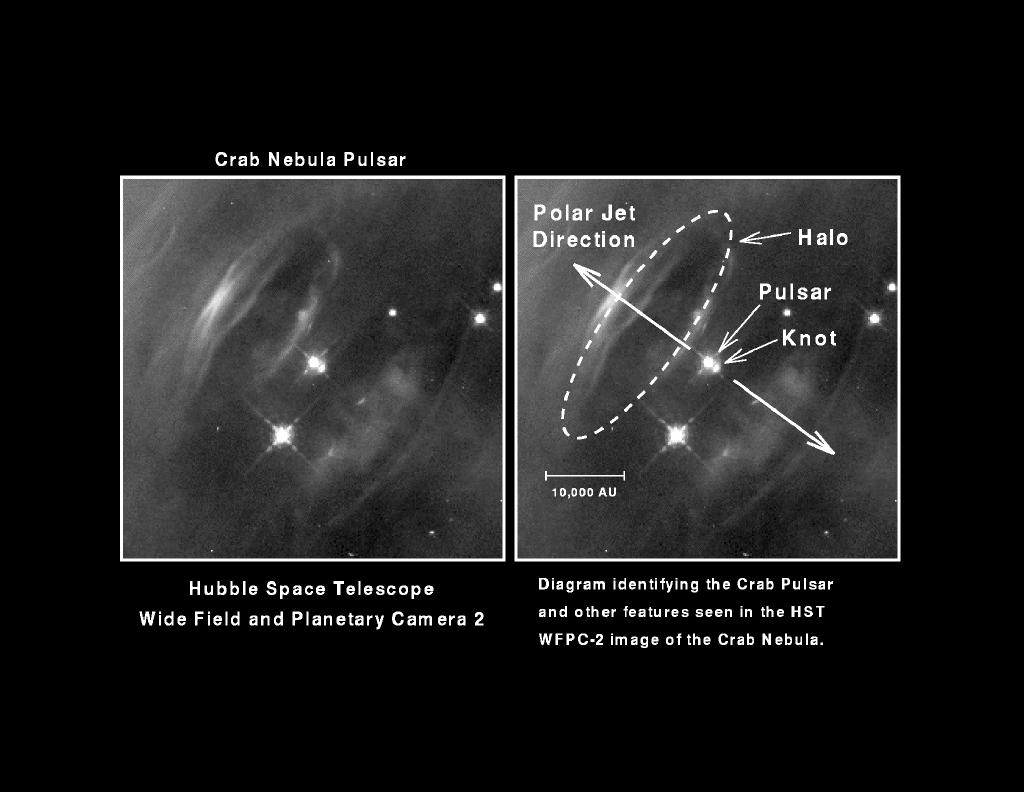
Credit: Hubble Space Telescope
Caption: Crab Nebula Pulsar
What is a Pulsar?
Basic Object: A star
Size: 20 km in diameter (that’s the distance from the tip of Alki Beach to the middle of downtown Bellevue.)
What makes it cool: It has a beam of light that is swinging around like a lighthouse, causing the star to appear to “pulse” THIS INFORMATION MAY BE OUT OF DATE. IT WAS TRUE OF OUR UNDERSTANDING OF HOW PULSARS WORK IN 2008, BUT FINDINGS REVEALED AT THE AAS JANUARY MEETING IN 2009 MAY HAVE CHANGED THIS. I HAVEN’T READ THE PAPERS YET.
Discovery attributed to: Jocelyn Bell Burnell
Discovery Year: 1967
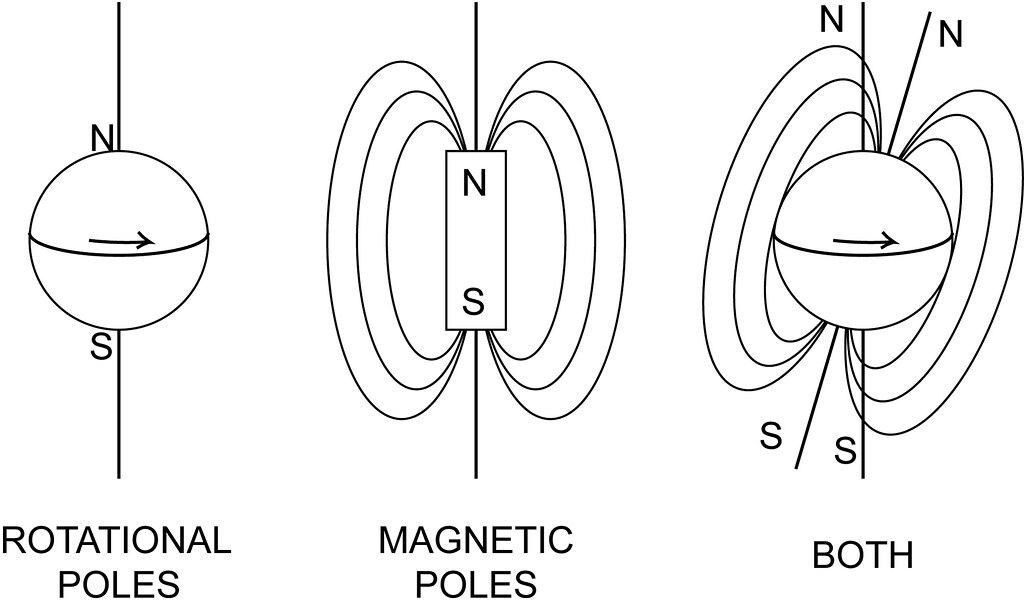
Caption: Earth’s Various Poles
A pulsar is a neutron star that’s spinning in a special way. (Remember, everything in the universe spins). First you need to know something about poles. The Earth has two north poles and two south poles. Yes, it’s true. One set is because the Earth is spinning: the poles are the tips of the axis that the Earth spins on. The other set is because the Earth has a magnetic field: all magnets have a north side and a south side. On Earth, these two sets of poles are slightly misaligned.
In a pulsar, the poles are even more misaligned, so as the star spins, the magnetic field is swung around in circles. When this happens to a neutron star, you get a super-bright beam of light beaming out from the magnetic poles. Since these poles are swinging around, so do the beams of light – just like a lighthouse.
“Light” in this case can also mean X-Rays, Gamma-Rays, or other invisible kinds of light. To learn more about neutron stars, refer to the links below.
What is a Quasar?
Basic Object: The middle of an active galaxy
Size: too far away to measure, but they comprise the entire middle section of their galaxy, encompassing many stars.
Cool Fact: Quasar is short for QUASi-stellAR radio source, or QSO: Quasi-Stellar Object
Original Discovery attributed to: Cyril Hazard, Maarten Schmitt and their co-workers
Discovery Year: 1950s
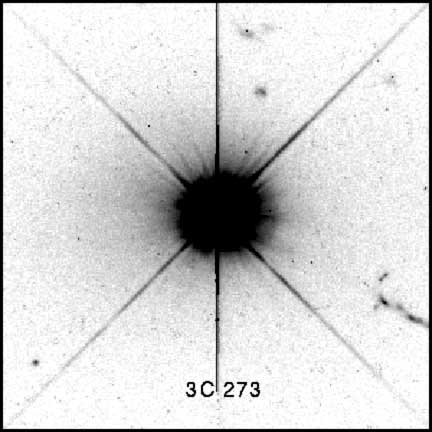
Credit: Hubble Space Telescope, John Bahcall
Caption: Quasar with Spikes
When quasars were first discovered, no one knew what they were. On the photographic plates the objects looked like bright stars. In most deep-space photographs stars have spikes; it’s one of the ways you can tell if you’re looking at a galaxy or a star. (They’re called diffraction spikes, and are just an artifact of the photograph). Unfortunately, the light from these “stars” was very odd: the spectrum didn’t match up with any known star types. So, the scientists said they were “quasi-stellar.”

Credit: Hubble Space Telescope, John Bahcall
Caption: Quasar Looking Like a Galaxy
It took them years to realize that the spectra were weird because the quasars were humongously far away. They were farther away than anything that had ever been seen. (If you want to know how distance will change the spectra of stars and galaxies look up “redshift” in your favorite astronomy reference book or website). Also, as telescopes got better, astrophysicists noticed that quasars didn’t really look quite as much like stars as they had originally thought.
When scientists realized how far away quasars actually were (up to 13 billion light years away), they also realized that the quasars must be amazingly bright. We now know that they’re some of the brightest things out there: a halo of high-energy matter around a black hole at the center of a baby galaxy.
So, quasars are special because they’re some of the farthest-away things that we can detect.
Brain Games
Still having trouble keeping the words quasar and pulsar straight? Here’s my mnemonic: “Quasar means QUASi-stellAR, which is NOT a star, Pulsar means it pulses, flashing like a lighthouse.”
Want More?
Pulsars
http://imagine.gsfc.nasa.gov/docs/science/know_l1/pulsars.html
Related Topics: Neutron Stars, Black Holes, Magnetic Fields
Quasars
http://csep10.phys.utk.edu/astr162/lect/active/quasars.html
Related Topics: Active Galaxies, Active Galactic Nuclei (AGN), Redshift, Expansion of the Universe, Black Holes
 Exo-Earth around Gliese 581?
Exo-Earth around Gliese 581?
A new planet has been discovered around a distant star, not that this in itself would be news – it seems that new planets are discovered around other stars every few days. Usually, though, these planets are several times the size of Jupiter, or are sometimes as “small” as Uranus or Neptune. Though exciting, these planets aren’t the best fodder for science fiction enthusiasts and don’t inspire dreams about terra-forming Earth 2.0.
This planet is different. Creatively named “Gliese 581 c” this planet is only five times more massive than the Earth. More importantly, this new planet is within the “habitable zone” around its star. It orbits a lot closer (0.073 AU) to Gliese 581 than Mercury orbits around our Sun.
Habitable Zones
As you know, Mercury is one of the hottest planets in our solar system due to its proximity to the Sun; it would be a nasty place to live, and humans wouldn’t last long. The star Gliese 581 is different: it’s a red dwarf star, tiny, dim, and not very warm compared to our Sun. Assuming this planet is rocky like Earth, and has a bit of an atmosphere, this close orbit would make it perfect for liquid water.
In current astronomy, liquid water is the gold of the universe: the key ingredient needed to even hope that life exists on a planet or moon. The discoverers of this planetary system estimate that the average temperature on Gliese 581 c is between 0 and 40oC (32 and 104oF).
Earth 2.0?
So, it’s time to break out the terra-forming equipment, jump on the Enterprise, zip over and see what’s there, right? Well, perhaps we’d better invent light-speed travel first – Gliese 581 is still 20 light years away. On the other hand, perhaps we should protect the habitable planet we’ve got, and turn our terra-forming eyes back on re-terra-forming the Earth, and keeping it habitable.
Statistics
Discovered by: Udry, Bonfils, Delfosse, Forveille, Mayor, Perrier, Bouchy, Lovis, Pepe, Queloz, and Bertaux from the Geneva Observatory, Switzerland.
Discovered using: the HARPS (High Accuracy Radial velocity Planet Searcher) instrument at La Silla Observatory, Chile.
Star: Gliese 581 is 20 light years away, in the constellation Libra. Though Libra is visible tonight (rising around 10:30pm), you won’t see Gliese 581 – it is too dim.
Planet: one of three planets discovered in the system so far, Gliese 581 c is 5.03 times the mass of Earth, orbits at 0.073 AU, and 1.5 times the diameter of Earth.
Alice Enevoldsen
Where’d I Get My Info?
http://www.sciam.com/article.cfm?articleID=25A261F0-E7F2-99DF 313249A4883E6A86&chanID=sa007
http://exoplanet.eu/planet.php?p1=Gl+581&p2=c
http://en.wikipedia.org/wiki/Gliese_581_c
The original press release by the ESO (European Organisation for Astronomical Research in the Southern Hemisphere):
http://www.eso.org/outreach/press-rel/pr-2007/pr-22-07.html
The real deal – Here’s the scientific paper Udry et al submitted:
http://obswww.unige.ch/~udry/udry_preprint.pdf
And their website:
 The Tropics
The Tropics
What are the tropics of Cancer and Capricorn?
Think of the tropics of Cancer and Capricorn like the equator. On the Spring and Autumn Equinoxes (such as the one that just passed on March 20th) if you stand on the equator at noon the Sun will be directly overhead (at 90o). Here in Seattle the highest the Sun ever appears in the sky (at noon on the Summer Solstice) is 65o.
Because the Earth is tilted, on the solstices the Sun is further north or south in the sky than it is on the equinoxes. So, if you stand on the equator, the Sun is no longer directly overhead. On the Summer Solstice, if you stand on the Tropic of Cancer (the northern Tropic) the sun will be directly overhead. On the Winter Solstice, if you stand on the Tropic of Capricorn (the southern Tropic) the sun will be directly overhead.
Here are some pictures to illustrate this.
![]()
~ A l i c e !
 Stellar Clusters
Stellar Clusters
There are two classifications of star clusters: globular clusters and open clusters. You can see some examples of each with the naked eye in tonight’s night sky, but there are even more that can be seen with binoculars and low-power telescopes. There are also distinct differences between the two types.
Globular Clusters:
Globular clusters are full of the wizened old stars of the galaxy. These stars have been around for 12 to 20 billion years (edited to add: as Ken pointed out, this would make these stars older than the universe which isn’t true. This estimate was come up with by analyzing the spectra of the cluster, and it should be limited by the age of the universe, so 12-14 billion years is a better number to keep in mind), and they clump tightly together in groups of about 10,000 to 1 million stars.
Globular Clusters are the oldest stars in our galaxy (called “Population II” by astronomers). These are also pretty much the only stars in our galaxy that you’ll find orbiting above or below the main “disk” of the Milky Way. If you imagine our galaxy as a sphere, almost everything (including us, black holes, and most other stars) is in a Frisbee-shaped disk filling up the middle of the sphere – leaving most of the sphere empty. Globular clusters can be anywhere inside that sphere. This is also where we suspect most of the dark matter in our galaxy to be.
Age: 12-20 14 billion years old
Number: 10,000 to 1,000,000 stars
Size: A sphere 10-200 light-years in diameter
Good Cluster to See Tonight: The Hercules Globular Cluster (M13), in Hercules – rising a little north of due East around 11 p.m. You’ll see the dimmest little fuzzy patch near Hercules’ leg. You may have to look away and use your peripheral vision to see it.
Open Clusters:
Open clusters are the uppity young sprouts. They’re usually less than 100 million years old, and group together in gangs of about 100 stars. The spectacular thing about open cluster stars is that they’re all from the same “litter,” the stars usually all formed together out of the same diffuse nebula, which you can sometimes see – as in the Pleiades.
Age: Less than 100 million years old
Number: Commonly 100-ish stars (less than a few thousand)
Size: A sphere 3-20 light-years in diameter
Good Clusters to See Tonight: The Pleiades and the Hyades, in Taurus – setting near West around 11 p.m. The Pleiades are a tiny group of what looks to be 6-8 stars. The Hyades are a medium-sized V of stars that makes the “face” of Taurus the bull.
Where’d I Get My Info?
PSC’s 2007 March-April Starmap
http://en.wikipedia.org/wiki/Population_II
 What is Hawking Radiation?
What is Hawking Radiation?
Hawking Radiation is the process by which black holes evaporate. Usually only small black holes actually evaporate, though Hawking Radiation is believed to happen to all black holes.
Background Information:
In spite of conservation of matter, we can assume that matter can be created from nothing, as long as it disappears quickly enough for the universe “not to notice.”
If you imagine that a particle is created from nothing, you can get away with it if its antiparticle (like a positive number and a negative number) is also created from nothing right next to it. The two particles immediately combine – going back into nothingness ((+1) + (–1) = 0). These imaginary particles are “virtual particles,” and their appearances and disappearances are called Vacuum Fluctuations.
An Instance of Hawking Radiation:
I’m going to write this in steps.
1. A black hole exists. Anything that ends up within the black hole’s event horizon ultimately falls into the black hole, adding its mass to that of the black hole. It can never escape.
2. A virtual particle pair springs into existence RIGHT ON the event horizon.
3. Before the two particles can annihilate (combine and disappear) one falls into the black hole’s event horizon. OH NO!
4. The second virtual particle is stuck! It can’t disappear anymore since its pair (its soulmate if you will) is gone forever!
5. The universe “notices” the existence of an extra particle by the black hole.
6. The extra particle is outside the black hole’s event horizon, and it’s a real particle now, not a virtual one because it existed for too long and the universe noticed.
7. But wait! You’re NOT ALLOWED to create something from nothing, so this particle had to come from somewhere.
8. The universe asks its bookkeepers where this extra particle came from.
9. The bookkeepers scramble. (They’re being audited.) Ummm… no one will notice if we take a little of the energy from the black hole, will they?
10. Clearly the energy for this new particle must have come from inside the black hole.
11. The black hole is now down one particle’s worth of energy. (Another way to think of this is that the virtual particle that fell in had “negative” energy – absorbing some energy from the black hole).
If you weren’t following all this anthropomorphizing of the universe, it looks like a particle is now beside the black hole, and the black hole is a little smaller.
In effect, the black hole has evaporated a little bit. Big black holes are sucking in so much mass that this tiny evaporation doesn’t have any effect. Tiny black holes, on the other hand, evaporate faster than they can suck in matter. So if there were a one-atom black hole created on Earth, one might be afraid that it would suck in the atoms next to it, and the molecules next to that, and get bigger and bigger until it sucked in the Earth. Luckily a one-atom black hole would evaporate before that happened. At least, so say the physicists in Geneva who are trying to create tiny black holes.
Want More?
http://focus.aps.org/story/v16/st12
Where’d I Get My Info?
http://focus.aps.org/story/v16/st12
Astronomy classes at Whitman College
http://en.wikipedia.org/wiki/Hawking_radiation
 A Series of Questions (I)
A Series of Questions (I)
This was like taking my cumulative major exams all over again (without the math). I love you all.
–Alice
Why are there billions of stars?
I don’t know if anyone really knows how many stars there are in the universe. In our galaxy alone there are 100 billion-ish – and there are possibly hundreds of billions of galaxies.
There are billions of stars in our galaxy because of how the universe formed. There’s still a debate about which came first the chicken or the egg … I mean the star or the galaxy. Either the stars formed out of the primordial gasses of the universe and then were attracted (by their own gravity) into groups that we now call galaxies, OR the primordial gasses swirled into galaxy-sized clumps which then condensed (in little bits) to form the stars of those galaxies. Either way we ended up with billions of stars per galaxy.
How long do they last for?
An average star, like our Sun, lives for about 10 billion years. Our Sun is currently 4.5 billion years old – you have a while to wait until you worry about the end of the world.
Supergiant and giant stars burn out after only a few million years.
Weird stars like white dwarfs, pulsars, and neutron stars pretty much last “forever” unless something happens to them. We are unable to fathom how long they might last – 100s of billions of years? More? The universe hasn’t been around long enough for any of these types of stars to die.
Remember it this way: the bigger a fire you are, the hotter and faster you burn. Big stars burn out fast, little stars burn less fuel at a time and last a long time.
Can astronomy change?
Our understanding of astronomy is constantly changing.
For example, in 1999 astronomers were estimating that there were 125 billon galaxies in the entire universe. The new Hubble camera showed us twice as many galaxies as we were expecting to be able to see. Astronomers had to revise their predictions.
Is everything about astronomy true?
This is a philosophy question (relating to critical thinking and belief), not an astronomy question :) You’ll have to answer it yourself, that’s how philosophy works.
Science is based on hypotheses and observations. The explanations that best fit the evidence become stronger. In science you’ll never reach a true “fact,” because you can always keep testing your hypothesis. When most people agree that the evidence says your hypothesis is correct it becomes a theory. Theory is the closest you can get to fact: it’s something that’s “pretty for sure,” and something that lots of people agree seems to work.
I’d say “No, everything we believe we understand about astronomy is not true.” (Soon someone will find something we’re wrong about again, they keep doing it). I would also say “Yes, in truth the universe exists, and exists according to its own true rules.” Now go think about that for the next ten years and you’ll get a Ph.D. in Astrophysics or Philosophy. :)
What is gravity?
Gravity is a force between any two masses. (A force is something that can cause motion)
Gravity is one of the four basic forces of the universe: we can explain its effects but not its existence. The other forces are:
Electromagnetic force – causes positive and negative charges or North and South poles to be attracted to each other
Strong force – keeps a proton (or a neutron) from falling apart, and what keeps an atom in one piece
Weak force – has weird things to do with nuclear particle physics. (I hope those big words scared you because I can’t explain the weak force any better than that – I don’t understand it). Factoid: it’s the only force that can easily effect neutrinos.
What’s the strongest telescope?
Gamma Rays: Compton (decommissioned – was in space), Chandra now.
X-Ray: Chandra X-Ray Observatory in space
Ultraviolet: Hubble in space, I think.
Visual: Keck and Keck II in Hawaii, or the VLT (Very Large Telescope) in Chile, or SALT (South African Large Telescope) in South Africa, or the new one coming up in Germany (LBT – Large Binocular Telescope), Hubble’s good too, being in space.
Radio: Arecibo Observatory in Puerto Rico or the VLA (Very Large Array) in New Mexico
Infrared: Spitzer (used to be called SIRTF) in space
NASA’s Four Great Observatories: Hubble (Visual), Compton (Gamma), Chandra (XRay), Spitzer (Infra-red)
Will the universe expand forever or collapse?
The person who answers this question will win the Nobel Prize in Physics. What are you waiting for? Get started! Study this:
<<IMAGE NOT INCLUDED YET!>>
More? http://rst.gsfc.nasa.gov/Sect20/A9.html
What is the black hole at the center of the Milky Way?
It’s a black hole (or several) at least 2 million times the mass of the Sun. It may be the powerhouse that keeps pulling on all the stars in the galaxy, causing them to swing around the center of the galaxy in orbits.
More? http://antwrp.gsfc.nasa.gov/apod/ap021018.html
How is the Doppler Effect used to find out planet sizes?
As a planet orbits a star it tugs on the star. (Gravity always goes two ways). This causes the star to wiggle back and forth a little. If the planet is lined up right, the star moves towards and away from the Earth a little. As the star moves towards the Earth (a little) the light waves coming towards us are compressed and become a little bluer. As the star moves away from the Earth (a little) the light waves coming towards us are stretched out and become a little redder: thus red-shift and blue-shift. This is the same as the Doppler Effect.
Depending on the mass of the planet, the star will wiggle more or less (more for a bigger planet, less for a smaller planet). We can measure how much the light waves are stretched and compressed, and can know how much the star is moving, and therefore how much mass the planet has.
How effective is it for Earth-size objects?
::snort:: We all wish it were. It’s not at all. We can only find Jupiter-ish sized planets this way. For Earth-sized planets we’ll have to wait until the Kepler mission gets going. It’s detecting planets using the “Transit Method.” It looks for planets to go in front of stars and block out some of their light. It’s going to stare at the same 100 stars in the same part of the sky (near the Summer Triangle) for four or five years trying to detect planets this way.
What uses does astronomy have?
The age-old question, I’ve been working out a good answer to this question for years. I’m not done yet, but here’s what I have so far.
First: Understanding. We cannot understand our universe until we study it.
Second: Legacy. We (21st-century humanity) are not going to build pyramids: we’re going to build a legacy of knowledge and information.
Third: Discovery. By studying the universe and gaining understanding we may discover (either “out there” or through the technology we use to study “out there”) the answers to mysteries and problems closer to home (starvation, poverty, international cooperation, disease).
Fourth: Hope. Are we alone? Many people hope we’re not. What is the meaning of life? Besides “42,” many people hope that our discoveries in astronomy may lead us closer to an answer.
Why do supernovas happen?
There are two kinds of Supernovae: Supernovae Type Ia and Type II.
Type Ia (white dwarf and giant star)
Type Ia supernovae occur when you have two stars orbiting in a binary system: a white dwarf star and a larger companion star. If they’re close enough together, gasses fall from the bigger star onto the white dwarf, and if this happens too fast, the star explodes.
Type II (one star dying):
A star stays star-sized the same way a balloon stays balloon-sized: competing forces. In the case of a Helium balloon the Helium is pushing out, trying to escape from the balloon. If it weren’t for the air around the balloon, it would explode – allowing the Helium to escape. The air (the atmosphere) is pushing back on the balloon, trying to flatten it.
In the case of a star, the energy from the fusion reaction at the core of the star is pushing out, keeping the star big, and gravity is pushing in, trying to collapse the star into a neutron star or black hole. As long as the fusion keeps going, the star stays “inflated.” A star starts by fusing Hydrogen atoms together to make Helium atoms. When it’s used up all its Hydrogen it starts fusing Helium atoms into Carbon, Nitrogen and Oxygen. When it’s done with that it keeps on going, fusing smaller atoms into bigger ones until it gets to Iron (Fe). All of these reactions release energy, allowing the star to shine and stay “inflated.”
Unfortunately Iron doesn’t give energy back when it’s fused. Since there’s no longer fusion energy pushing out inside the core of the star, gravity begins to win. The star starts to collapse: squishing all the atoms in the star closer together, fast. This creates a very, very, very dense and heavy core to the star. The core is so dense and heavy that the outer layers of the star (that are still being pulled in by gravity) “bounce” off the surface of this core. They bounce so hard they’re thrown off into space making the biggest explosion we know of: a supernova. It also leaves behind a neutron star (that super-dense core).
What are some current studies/research being conducted about space?
Spitzer. STEREO. CloudSat. Mars Reconnaissance Orbiter. Genesis. ICEsat. Stardust.
What is the difference between quasars and pulsars?
Quasars (QUAsi-StellAr Radio sourceS) are galaxies. Pulsars are stars.
Quasars are areas in galaxies of intense activity – usually thought to be super-massive black holes at the centers of the galaxies. Pulsars are rotating neutron stars.
How important is Hawking Radiation?
It’s not going to bring about the end your life. Actually it may have already saved your life.
HERE’S THE WEIRD PART: Due to conservation of matter, we can assume that matter can be created from nothing, as long as it disappears quickly enough for the universe “not to notice.” If you imagine that a particle is created from nothing, you can get away with it if its antiparticle (like a positive number and a negative number) is also created from nothing right next to it and they immediately combine – going back into nothingness ((+1) + (–1) = 0). These imaginary particles are “virtual particles.” These effects are called Vacuum Fluctuations.
Okay. I’m going to write this in steps.
1. A black hole exists.
2. Anything that ends up within the black hole’s event horizon ultimately falls into the black hole, adding its mass to that of the black hole. It can never escape.
3. A virtual particle pair springs into existence RIGHT ON the event horizon.
4. Before they can annihilate (combine and disappear) one falls into the black hole’s event horizon. OH NO!
5. The second virtual particle is stuck! It can’t disappear anymore, its pair (its soulmate if you will) is gone forever!
6. The universe notices.
7. An extra particle is now outside the black hole’s event horizon. It’s a real particle now, not a virtual one because it existed for too long and the universe noticed.
8. But wait! You’re NOT ALLOWED to create something from nothing, so this particle had to come from somewhere.
9. The universe asks its bookkeepers where this extra particle came from.
10. The bookkeepers scramble. They’re being audited. Ummm… no one will notice if we take a little of the energy from the black hole, will they?
11. So, clearly the energy for this new particle must have come from inside the black hole.
12. The black hole is now down one particle’s worth of energy. (Another way to think of this is that the virtual particle that fell in had “negative” energy).
13. So, if you weren’t following all this anthropomorphizing of the universe (If you don’t like the fact that I made the universe act like a person) – ::poof:: it looks like a particle is now beside the black hole, and the black hole is a little smaller.
In effect, the black hole has evaporated a little bit. Big black holes are sucking in so much mass that this tiny evaporation doesn’t have any effect. Tiny black holes, on the other hand, evaporate faster than they can suck in matter. So if there were a one-atom black hole created on Earth, one might be afraid that it would suck in the atoms next to it, and the molecules next to that, and get bigger and bigger until it sucked in the Earth. Luckily a one-atom black hole would evaporate before that happened. At least, so say the physicists in Geneva who are trying to created tiny black holes.
More? http://focus.aps.org/story/v16/st12
 Mercury at Greatest Elongation 2007
Mercury at Greatest Elongation 2007
Although Mercury is often in our sky and listed as being “visible,” it’s usually quite hard to find. As the closest planet to the Sun in our solar system, Mercury is only visible just after sunset, or right before sunrise. This means that you’re looking for Mercury low in the sky – through whatever muck is in the atmosphere – and through dimming twilight, the hardest time of night to see anything. It’s not light enough to see objects on Earth, and it’s too light to see the stars. To see Mercury you usually have to know exactly where to look.
Get ready, because this will all be different very soon! On February 7, 2007, Mercury will be at “greatest elongation,” the furthest it ever gets from the Sun from our point-of-view. So, it might actually be completely dark when you’re looking for it.
Where to Look:
Between 5:00pm and 5:30pm, look in the southwest region of the sky. Venus will also be visible during this time (in fact, Venus will be the brightest thing you can see in that area). Mercury is just a little further west and a little closer to the horizon, in the constellation Aquarius.
Vocabulary:
What always frustrates me about “greatest elongation” is that I get it confused with all those other orbital vocabulary words. Let me see if I can set them straight.
Greatest Elongation: When an object appears in our sky to be as far from the Sun as it can possibly get. This only happens to inner planets.
Perihelion: Point in an object’s orbit closest to the Sun.
Aphelion: Point in an object’s orbit furthest from the Sun.
Opposition: When the Earth is directly between an object and the Sun – opposite from the Sun. (For instance, during a lunar eclipse, the Moon is at opposition).
Conjunction: When an object is in approximately the same part of our sky as the Sun in conjunction with the Sun. There are two kinds of conjunction: When the Sun is directly between the Earth and a body (superior conjunction), or when a body is directly between the Earth and the Sun (inferior conjunction).
Want More?
http://en.wikipedia.org/wiki/Astronomical_opposition
Where’d I Get My Info?
http://en.wikipedia.org/wiki/Astronomical_opposition
![]()
~ A l i c e !
 March Lunar Eclipse
March Lunar Eclipse
June 2010: I feel the need to update this. Below I mention two lunar and two solar eclipses each year. Poking through some predictions of future eclipses I’ve found four lunars in 2009 and four solars in 2011. Other than that, there do seem to be two a year. Now I have to figure out exactly why, but my suspicion is that it has to do with perfecting the math, and that a lot of those “extra” eclipses are not total.
Original Post:
Here’s some news ahead of time for you. On March 3, 2007 there will be a total lunar eclipse. Unfortunately, it will be best viewed from the middle of Africa. Here in Seattle, we’ll see just the tail end of the eclipse which will appear as a dark shadow covering a small section near edge of the moon as it rises at 6:00 p.m.
Luckily for us, there are two lunar eclipses a year! On August 28, 2007 we’ll get to see the whole show – a total lunar eclipse best viewed from the West Coast of North America.
Before you read the next part, I have a caveat to mention: everything depends on where you’re standing. If you were standing above our solar system, you would see that the Earth goes around the Sun, the Moon pretty much goes around the Earth, and the Sun doesn’t go anywhere. If you were standing in the middle of the galaxy, you’d see all that, but the Sun would be traveling around the galaxy also. From standing on Earth, it looks like the Sun moves around us, even though it doesn’t. Since we’re talking about observing eclipses, what it looks like from Earth is more important than what it looks like from outer space.
Why are there Two Lunar Eclipses and Two Solar Eclipses Each Year?
Update, according to Mr. Eclipse (who I trust, since NASA does) there are between 2 and 5 solar eclipses each year. I ASSUME this means there are between 2 and 5 lunar eclipses as well.
Take any two rings of approximately the same size: two hula hoops, two key rings, the two rings from an embroidery hoop, or two bangle bracelets. I’m going to use hula hoops.
If you stand inside the hula hoop, you’re the Earth, and the hoop is the path the Sun follows as it seems to travel through your sky, the ecliptic. The Sun takes one year to trace this path. Now, stand inside the other hula hoop. This is the path the Moon travels through your sky. It’s very close to the ecliptic, but isn’t quite the same.
Time to use your dexterity! Using both hula hoops, hold them together, one on top of the other (Image 1). They should be touching all the way around. Now, tilt one a little. The one you’ve tilted should go down through the middle of the other (Image 2). These are the Sun’s path and the Moon’s path. How many places are they touching?
The Sun’s traveling along one hoop, crawling 1/12th of the way around the hoop every month. The Moon is zooming around the other hoop, covering the entire distance in one month. When the Sun finally arrives at one of the intersections (a node) it will still be there when the Moon gets to the same intersection, since it’s moving so slowly. This is a Solar Eclipse. Two weeks later, the Sun hasn’t moved much, and the Moon is at the opposite intersection (node) forming a Lunar Eclipse!
There’s a lot more to tell about eclipses, I’ve simplified a little, but that’s the basic reason we have two of each per year.
Want More?
http://www.mreclipse.com/MrEclipse.html
Beautiful and Artful Photographs of Lunar Eclipses by Laurent Laveder (http://www.pixheaven.net/photo.php?nom=060907_1926)
Where’d I Get My Info?
Eclipse Predictions by Fred Espenak, NASA/GSFC (Mr. Eclipse himself)
http://skytonight.com/observing/objects/eclipses/3304006.html\
http://sunearth.gsfc.nasa.gov/eclipse/eclipse.html
http://aa.usno.navy.mil/data/docs/UpcomingEclipses.html


